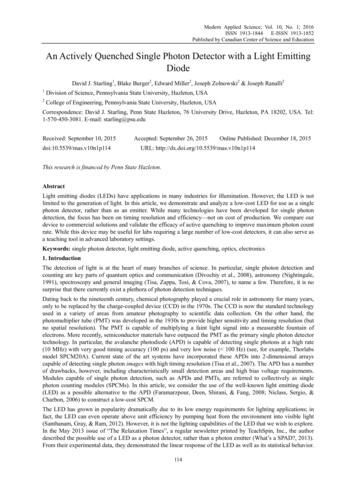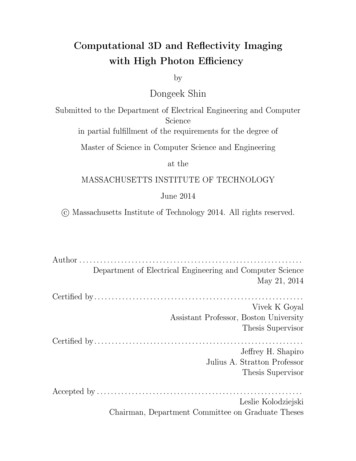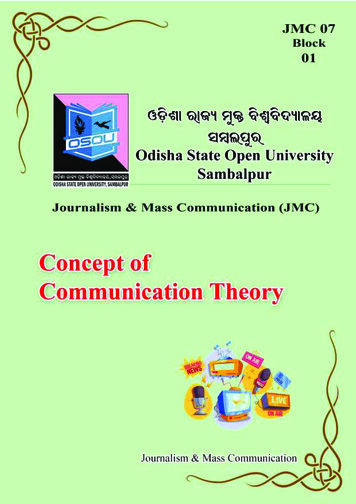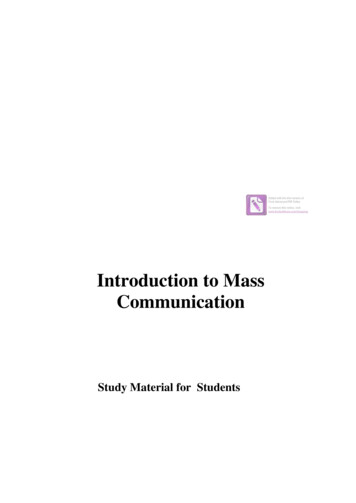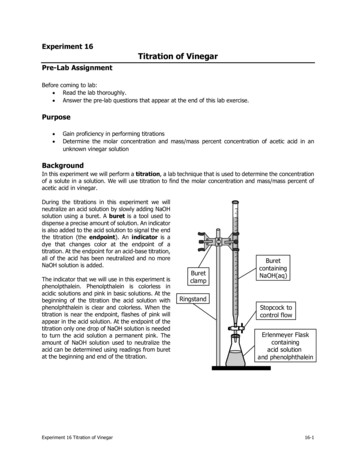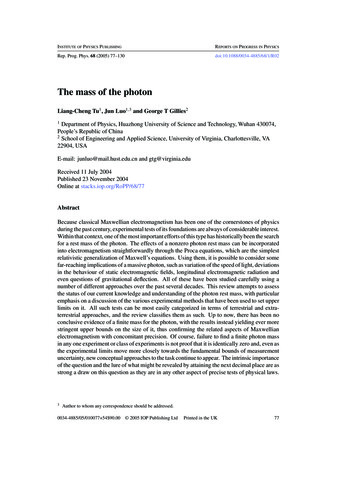
Transcription
INSTITUTE OF PHYSICS PUBLISHINGREPORTS ON PROGRESS IN PHYSICSRep. Prog. Phys. 68 (2005) 77–130doi:10.1088/0034-4885/68/1/R02The mass of the photonLiang-Cheng Tu1 , Jun Luo1,3 and George T Gillies21Department of Physics, Huazhong University of Science and Technology, Wuhan 430074,People’s Republic of China2School of Engineering and Applied Science, University of Virginia, Charlottesville, VA22904, USAE-mail: junluo@mail.hust.edu.cn and gtg@virginia.eduReceived 11 July 2004Published 23 November 2004Online at stacks.iop.org/RoPP/68/77AbstractBecause classical Maxwellian electromagnetism has been one of the cornerstones of physicsduring the past century, experimental tests of its foundations are always of considerable interest.Within that context, one of the most important efforts of this type has historically been the searchfor a rest mass of the photon. The effects of a nonzero photon rest mass can be incorporatedinto electromagnetism straightforwardly through the Proca equations, which are the simplestrelativistic generalization of Maxwell’s equations. Using them, it is possible to consider somefar-reaching implications of a massive photon, such as variation of the speed of light, deviationsin the behaviour of static electromagnetic fields, longitudinal electromagnetic radiation andeven questions of gravitational deflection. All of these have been studied carefully using anumber of different approaches over the past several decades. This review attempts to assessthe status of our current knowledge and understanding of the photon rest mass, with particularemphasis on a discussion of the various experimental methods that have been used to set upperlimits on it. All such tests can be most easily categorized in terms of terrestrial and extraterrestrial approaches, and the review classifies them as such. Up to now, there has been noconclusive evidence of a finite mass for the photon, with the results instead yielding ever morestringent upper bounds on the size of it, thus confirming the related aspects of Maxwellianelectromagnetism with concomitant precision. Of course, failure to find a finite photon massin any one experiment or class of experiments is not proof that it is identically zero and, even asthe experimental limits move more closely towards the fundamental bounds of measurementuncertainty, new conceptual approaches to the task continue to appear. The intrinsic importanceof the question and the lure of what might be revealed by attaining the next decimal place are asstrong a draw on this question as they are in any other aspect of precise tests of physical laws.3Author to whom any correspondence should be addressed.0034-4885/05/010077 54 90.00 2005 IOP Publishing LtdPrinted in the UK77
78L-C Tu et alContents1. Introduction2. General theory of massive photon electromagnetism3. Implications of a photon mass3.1. The dispersion of light3.2. The Yukawa potential in static fields3.3. The longitudinal photon3.4. Special relativity with nonzero photon mass3.5. AB and AC effects with finite photon mass3.6. Monopoles and the photon mass3.7. The Casimir effect for massive photons3.8. Photon mass and blackbody radiation3.9. Other implications4. Laboratory limits on the photon mass4.1. General introduction4.2. Measurement of the wavelength independence of the velocity of light4.3. Null tests of Coulomb’s inverse square law4.3.1. Historical review of Coulomb’s law4.3.2. General method and technical background4.3.3. Static experiments4.3.4. Dynamic experiments4.3.5. Other experiments4.4. Tests of Ampère’s law4.5. Torsion balance methods4.6. Other approaches5. Extra-terrestrial limits on the photon mass5.1. General introduction5.2. Dispersion of starlight5.3. Magnetostatic effects5.3.1. Schrödinger external field5.3.2. Altitude-dependence of massive photon geomagnetic fields5.3.3. Eccentric dipole effects due to a massive photon5.4. Magnetohydrodynamic effects5.4.1. Dispersion of hydromagnetic waves5.4.2. Dissipation of the interplanetary magnetic fields5.4.3. Stability of current density in the ISM5.4.4. Other methods5.5. Gravitational deflection of massive photons5.6. Present difficulties6. Possible future improvements6.1. Terrestrial 9122122122124124
The mass of the photon6.2. Extra-terrestrial detection6.3. Concluding remarksAcknowledgmentsReferences79125125126126
80L-C Tu et al1. IntroductionOne of the major triumphs of nineteenth century physics was the formulation by Maxwell ofa unified mathematical description of the classical electromagnetic field. A basic implicationof Maxwell’s electromagnetism is the constant speed, in vacuum, of all electromagneticradiation. Experimental studies have indeed confirmed to a high degree of accuracy thatall electromagnetic radiation travels at the speed of light, c, over a wide range of frequencies.In turn, this implies that the quantum of light, or photon, appears to be massless. However,it has energy hν, linear momentum hν/c, and a spin angular momentum with eigenvalues of h/2π( h̄), where h is the Planck constant and ν the frequency of the electromagneticwave. The enormous successes of quantum electrodynamics (QED) have led to an almosttotal acceptance of this concept of the massless photon. However, despite this acceptance,a substantial experimental effort has been made to determine, either directly or indirectly,whether the photon mass is zero or nonzero. From a theoretical perspective, if the rest massof the photon was found to be nonzero, classical electromagnetism and QED would remainuntroubled in spite of the loss of gauge invariance. Moreover, a finite photon mass is perfectlycompatible with the general principles of elementary particle physics, and an answer to thequestion of its size can be found only through experiments and/or observations.It is almost certainly impossible to do any experiment that would firmly establish that thephoton rest mass is exactly zero. The best one can hope to do is to place ever tighter limits onits size, since it might be so small that none of the present experimental strategies could detectit. According to the uncertainty principle, the ultimate upper limit on the photon rest mass, mγ ,can be estimated to be mγ h̄/( t)c2 , which yields a magnitude of 10 66 g, using an ageof the universe of about 1010 years. Although such an infinitesimal mass would be extremelydifficult to detect, there are some far-reaching implications of a nonzero value for it. Theseinclude a wavelength dependence of the speed of light in free space, deviations from exactnessin Coulomb’s law and Ampère’s law, the existence of longitudinal electromagnetic waves andthe addition of a Yukawa component to the potential of magnetic dipole fields, and all of thesehave been studied seriously. All these consequences of such an effect open the door to usefulapproaches for laboratory experiments or astrophysical/cosmological observations aimed atdetermining the photon mass or, more precisely, setting an upper limit on it.As the fundamental particle that mediates electromagnetic radiation, the photon conveysenergy and momentum through space-time and propagates in vacuum at the constant velocity c,independent of the frame of reference, as per the second postulate of Einstein’s theory ofspecial relativity. A corollary of this is that a particle with finite mass can never attain thespeed of light, c, or in other words, such a particle cannot exist in the frame of rest of aphoton. The fact that light could not be brought to a stand-still made this point of viewreasonable and it is theoretically difficult to find any kind of contradictory counter-example.Even so, experimental efforts to improve the limits on the rest mass of the photon have arisento challenge contemporary accepted theories, and this has been happening since the time ofCavendish, if not earlier, and in any case well before the modern concept of the photon wasintroduced.Questions central to the origin of and basis for the properties of elementary particles, suchas the neutrino, photon, graviton, axion, etc, including their masses, charges, and even theirexistence, are some of the most challenging in physics. For the photon, the Particle Data Groupfinds the currently accepted upper limit on the rest mass to be mγ 4 10 49 g 2 10 16 eV(Hagiwara et al 2002). The improved value of mγ 1 10 49 g 6 10 17 eV was reportedrecently by Eidelman et al (2004). These numbers are quite impressively small; almost 22orders of magnitude less than the mass of the electron. The possibility of a finite photon rest
The mass of the photon81mass remains one of the most important issues in physics, as it has a bearing on fundamentalquestions such as charge conservation and quantization, the possibility of charged black holes,the existence of magnetic monopoles and so on. It is our goal in this article to review theknown experiments in this field and evaluate their impact on our state of knowledge regardingthis question. In section 2, we introduce the theoretical foundation for massive photons, via adiscussion of the Proca equations and the consequent distinctness of ‘massive’ electromagneticfields compared with their purely Maxwellian equivalents. Using the Proca equations as astarting point, several possible observable effects associated with a nonzero rest mass of thephoton are developed in section 3. In sections 4 and 5, we then review the known terrestrialand extra-terrestrial approaches to searching for such effects and assess the results found forupper limits on the photon rest mass. Section 6 closes the review with a discussion of thepresent limitations of and possible improvements to the experimental situation.2. General theory of massive photon electromagnetismElectromagnetic phenomena in vacuum are characterized by two three-dimensional vectorfields, the electric and magnetic fields, E(x, t) and B(x, t), which are subject to Maxwell’sequations and which can also be thought of as the classical limit (limit in large quantumnumbers) of a quantum mechanical description in terms of photons. The photon mass isordinarily assumed to be exactly zero in Maxwell’s electromagnetic field theory, which isbased on gauge invariance. If gauge invariance is abandoned, a mass term can be added tothe Lagrangian density for the electromagnetic field in a unique way (Greiner and Reinhardt1996):L µ2γ1Fµν F µν jµ Aµ Aµ Aµ ,4µ02µ0(2.1)where µ 1γ is a characteristic length associated with the photon rest mass, Aµ and jµ arethe four-dimensional vector potential (A, iφ/c) and four-dimensional vector current density(J, icρ), with φ and A denoting the scalar and vector potentials, and ρ and J are the chargeand current densities, respectively. µ0 is the permeability constant of free space and Fµν is theantisymmetric field strength tensor. It is connected to the vector potential through Aν AµFµν .(2.2) xµ xνThe variation of Lagrangian density with respect to Aµ yields the Proca equation (Proca1930a,b,c, 1931, 1936a,b,c,d, 1937, 1938, de Broglie 1940): Fµν µ2γ Aµ µ0 Jµ .(2.3) xνSubstituting equation (2.2) into (2.3), we obtain the wave equation of the Proca vector field Aµ :( µ2γ )Aµ µ0 Jµ ,(2.4)where the d’Alembertian symbol is shorthand for / (ct) .equation (2.4) reduces to2( µ2γ )Aµ 0,22In free space,(2.5)which is essentially the Klein–Gordon equation for the photon. The parameter µγ could beinterpreted as the photon rest mass mγ , withmγ µγ h̄.c(2.6)
82L-C Tu et alWith this interpretation, the characteristic scaling length µ 1γ becomes the reduced Comptonwavelength of the photon, which is the effective range of the electromagnetic interaction. Anadditional point is that static electric and magnetic fields would exhibit exponential dampinggoverned by the term exp( µ 1γ r) if the photon is massive instead of massless.Therefore, a finite photon mass is accommodated in a unique way by changing theinhomogeneous Maxwell’s equations to the Proca equations. In the presence of sources ρand J, the three-dimensional versions of the Proca equations can be written in SI units asρ ·E µ2γ φ,(2.7)ε0 E B, t(2.8) · B 0,(2.9) B µ0 J µ 0 ε 0 E µ2γ A, t(2.10)together withB A,E φ (2.11) A t(2.12)and the Lorentz condition1 φ ·A 2 0,(2.13)c twhere ε0 and µ0 are the permittivity and permeability of free space, respectively. The Procaequations provide a complete and self-consistent description of electromagnetic phenomena.The equation for conservation of charge is obtained from equations (2.7) and (2.10) and theLorentz condition (2.13), so that ρ ·J 0.(2.14) tObviously, in massive photon electromagnetism, the Lorentz condition is identical to the lawof charge conservation, or in other words, the Lorentz condition is a necessary result of chargeconversation. Similarly, from equations (2.9), (2.10), (2.12) and (2.13), the equation forconservation of energy can be written as w(2.15) J · E, ·S twhere the Poynting vector, S, represents the energy flow density and w is the energy densityof the electromagnetic field (de Broglie 1940, Bass and Schrödinger 1955, Burman 1972a):1(E B µ2γ φA)(2.16)S µ0and 1 21 2 2122 2(2.17)ε0 E B ε 0 µγ φ µ A .w 2µ0µ0 γIn a Proca field, obviously, the potentials themselves have physical significance; it does notarise just through their derivatives. The scalar potential φ and the vector potential A describedby the Proca equations are observable since the potentials acquire energy density ε0 µ2γ φ 2 /2and µ2γ A2 /2µ0 , respectively. Phase invariance (U (1) invariance) is lost in Proca theory, but the
The mass of the photon83Lorentz gauge is automatically held, and this is indispensable to charge conservation, i.e. theLorentz condition becomes a condition of consistency for the Proca field. As a consequence,the field equation takes the form of equation (2.4). However, if mγ 0, the Proca equationswould reduce smoothly to Maxwell’s equations.The theoretical problem of describing the photon is profound and difficult, and thearguments presented can often be speculative and controversial. There is a huge literatureon this topic and the articles in it vary widely in their scope of investigation. A numberof the more well-known works in this area include (Feynman 1949, Coester 1951, Feldmanand Matthews 1963, Strocchi 1967, Chakravorty 1985, Masood 1991, Mendonça et al 2000).Although the theoretical problem is an area of great interest, it is not our objective here todwell on it, but rather to touch only on those fundamental principles that can help shed lighton the experimental consequences of a nonzero photon rest mass.3. Implications of a photon mass3.1. The dispersion of lightThe most direct consequence of a finite photon mass is a frequency dependence in the velocityof electromagnetic waves propagating in free space. From the Proca equations, the electricand magnetic fields in free space are given byAν exp[i(k · r ωt)],(3.1)where the wave vector k, the angular frequency ω and the rest mass µγ (note that here andin what follows, the rest mass of the photon µγ has units of reciprocal length (wave numbers),which is related to the mass mγ in grams by equation (2.6), i.e. 1 cm 1 3.5 10 38 g 2.0 10 5 eV) satisfy the Klein–Gordon equation,k 2 c2 ω2 µ2γ c2 .(3.2)The phase velocity and the group velocity (the velocity of energy flow) of a free massive wavewould then take the form 1/2 µ2γ c2µ2γ c2ωu c 1 ,(3.3) c 1 kω22ω2 1/2 µ2γ c2µ2γ c2dω, c 1 c 1 vg dkω22ω2(3.4)where k k 2πλ 1 with λ being the wavelength. Because of the nonzero photon mass, thedispersion produces a frequency dependence, and the group velocity will differ from the phasevelocity. In the Proca equations, c becomes the limiting velocity as the frequency approachesinfinity.For two wave packets with different propagating frequencies (denoted by ω1 and ω2 , andassuming ω1 ω2 µγ c), the velocity differential between them is given by 4 µ2γ c2µ2µ2γ c2 1vg1 vg2 v1 γ (λ22 λ21 ) O (µγ λ1 )4 . O cc28π 2ω22ω12ω12(3.5)
84L-C Tu et alIf the two waves move through the same distance L, the time interval between their arrivals isexpressed asLLL t (3.6)(λ2 λ21 )µ2γ ,vg1vg28π 2 c 2in which the terms of order higher than (µγ λ1 )4 are neglected. Equations (3.4)–(3.6) are thestarting points for detecting a dispersion effect due to the photon rest mass in both the terrestrialand extra-terrestrial approaches.3.2. The Yukawa potential in static fieldsThe next effect we discuss regarding massive photons arises in static fields. For a static electricfield (the case of a static magnetic field will be discussed in section 5), / t 0 and the waveequation reduces toρ( 2 µ2γ )φ .(3.7)ε0For a point charge ρ(r) Qδ(r), and equation (5.25) yields a Yukawa or Debye type ofpotential,1 Qexp( µγ r)4πε0 rand the electric field becomes Q1 µγE(r) exp( µγ r).4πε0 r 2rφ(r) (3.8)(3.9)Inspection of equations (3.8) and (3.9) shows that if r µ 1γ , the inverse square law is indeeda good approximation, but if r µ 1,thenthelawdepartsdrastically from the predictions ofγMaxwell’s equations. (Analogously, in a plasma, the static scalar potential does have a Debyeform,1 Qφ(r) (3.10)exp( µD r),4πε0 rwhere µD n e2 /ε0 T is the inverse Debye shielding distance, n is the plasma density andT (in joules) is the plasma temperature. Likewise, in a superconductor, a static magnetic fieldobeys( 2 µ2L )B 0,(3.11)where µL ωp /c is the London skin depth, with ωp ne2 /ε0 me denoting the electronplasma frequency.) So the static fields would be characteristic of exponential decay witha range µ 1γ . The exponential deviation from Coulomb’s law and its magnetic analogue inAmpère’s law provide many sensitive approaches to test for a photon rest mass in laboratoryexperiments, and these will be discussed in detail in section 4.3.3. The longitudinal photonMaxwell’s equations imply that a photon can be polarized in either of two directions, bothof which are orthogonal to the photon’s direction of motion. A nonzero rest mass of thephoton as described by the Proca equations would result in a third state of polarization, inwhich the vector of the electric field points along the line of motion and the particle is calleda ‘longitudinal photon’ (Greiner and Reinhardt 1996). Decomposition of E ET EL with
The mass of the photon85 · ET 0 and EL E L , and a similar decomposition of A, shows that the additional massterm in equation (2.16) describes pure longitudinal radiation while the term (E B) describespure transverse radiation, in which (EL B) is parallel to the surface of a large sphere aroundthe source (Nieuwenhuizen 1973). However, if the photon has a mass, it must be exceedinglysmall, since the effect of longitudinal photons has been too small to be detected up to thepresent (Goldhaber and Nieto 1971b, Burman 1972b,c, 1973).3.4. Special relativity with nonzero photon massIt is well-known that the electrodynamic constant c in Maxwell’s electromagnetic fieldrepresents the velocity of electromagnetic waves propagating in vacuum, and special relativitywas developed partly as a consequence of the constancy of the speed of light. However, one ofthe predictions of massive photon electromagnetic theory is that there will be dispersion of thevelocity of a massive photon in vacuum. The plane wave solution of the Proca equations withoutcurrent is Aν exp(ik µ xµ ), where the wave vector k µ (ω, k) satisfies the relationship inequation (3.2). It is shown in equation (3.4) that vg 0 for ω µγ c, namely the massivewave does not propagate. When ω µγ c, k becomes an imaginary quantity and the amplitudeof a free massive wave would, therefore, be attenuated exponentially. Only when ω µγ c,can the waves propagate in vacuum unattenuated. In the limit ω , the group velocity willapproach the constant c, which is consistent with Einstein’s assumption that there is a uniquelimiting velocity c for all phenomena. Therefore, a new postulate must be introduced in orderto restore the features of special relativity theory for photons of nonzero mass. The postulateis as follows (Goldhaber and Nieto 1971b): given any two inertial frames, the first moving atvelocity v with respect to the second, there exists a frequency ω0 , depending on v and thedesired accuracy ε, such that any light wave of frequency greater than ω0 will have a speedbetween c and c ε in both frames.A nonzero photon mass implies that the speed of light is not a unique constant but is afunction of frequency. In fact, the assumption of the constancy of the speed of light is notnecessary for the validity of special relativity, i.e. special relativity can instead be based on theexistence of a unique limiting speed c to which speeds of all bodies tend when their energybecomes much larger than their mass (Kobzarev and Okun 1968, Goldhaber and Nieto 1971b).Then, the velocity that enters in the Lorentz transformation would simply be this limitingspeed, not the speed of light.3.5. AB and AC effects with finite photon massThe well-known topological interference effect of Aharonov and Bohm (AB effect) concernsa phase shift for electrons diffracting around a tube of magnetic flux (Aharonov and Bohm1959), and it arises from the presence of a vector potential A in the Lagrangian of a particlewith mass m and velocity v ,mv 2(3.12) eA · v .2When an electron beam is split and then recombined, there will be a phase shift exp(i AB )from the interference effect (figure 1). The fluxL eeA · v dt B · dS(3.13)h̄h̄is through any surface bounded by the closed curve defined by the two paths, and it has beenobserved and measured in a series of experiments of Tonomura et al (1986).AB
86L-C Tu et AFigure 1. Schematic diagram of an experiment to demonstrate electron interference due to theAharonov–Bohm effect. The coherent beam of electrons is split into two parts, each passingthrough an aperture in the metal foil, and then going on the opposite sides of the solenoid, whichis shielded from the electron beams. The beams are steered by suitable devices A and B and thenbrought together in the interference region. The vector potential of the solenoid will produce ashift in the relative phase of the two electron beams.For massive photon (finite-range) electrodynamics, the Proca Lagrangian is of particularinterest and the resultant phase shift for an electron beam diffracted around either side of aninfinitely long solenoid was calculated by Boulware and Deser (1989). Although there is anextremely small magnetic flux leakage outside the solenoid because of the finite length of theapparatus, it can be adjusted in principle so that only the flux inside the solenoid contributesto the phase shift. The phase shift for this case is shown to reduce smoothly to that of thestandard AB effect in the limit of vanishing photon mass. An additional observable effect ispredicted from µγ R 2 · D,(3.14)2ABwhere D depends upon the details of the experimental configuration but is of order 1, R is thedistance from the solenoid to the observational location, and is the correction due to themassive photon. The authors used this to find a limit on the photon mass of mγ 4 10 45 g(corresponding to a reduced photon Compton wavelength of 102 km). To obtain a morestringent limit on the photon mass, however, the geometry and field strengths that wouldbe needed do not make this approach competitive with those of other experiments (Tonomuraet al 1986, Boulware and Deser 1989).An extension of the AB effect was presented by Aharonov and Casher (AC effect) (1984).They predicted that a neutral particle possessing a magnetic dipole moment should experiencean analogous phase shift when diffracted around a line of electric charge. The AC effect isan electrodynamic and quantum-mechanical analogue of the AB effect. Consider a magneticdipole of mass m and moment µ diffracted around an infinitely long line of charge with densityλ and let v be the dipole’s velocity; the particle’s Lagrangian will beL 21 mv 2 v · (E µ).(3.15)The relative phase of the split beam at the recombination point is exp(iAC µ·h̄E v dt µ·h̄E dr,AC )with(3.16)as was observed in the neutron interferometry experiment of Cimmino et al (1989).The AC effect in massive photon electrodynamics was demonstrated by Fuchs (1990).Consider the case where a magnetic dipole of moment µ is aligned along the line of electriccharge, which means the acceleration of the magnetic dipole vanishes and the AC phase shift
The mass of the photon87for the massive photon case then becomes4π µλ µ2γ µµ( ·E)dS φ dS,(3.17)ACh̄h̄h̄where the Proca version of Gauss’s law is used and the integral is taken over the area enclosingthe two paths. Noting that the potential for a point particle whose field is governed by theProca equations is simply the Yukawa potential, the line charge potential is found to be(3.18)φ(r) 2λK0 (µγ r),where K0 (x) is a modified Bessel function of the second kind. After integrating, the relativephase of the split beam at the recombination point R is4πµλ(3.19)µγ RK1 (µγ R).AC (R) h̄Note that since K1 (x) approaches x 1 as x vanishes, AC (R) approaches 4π µλ/h̄ as µγvanishes, which means this effect smoothly reduces to the standard effect for zero µγ (Aharonovand Casher 1984). In the limit that R approaches infinity, AC (R) vanishes. This is as expectedsince the photon mass causes the electric field to be of finite range. Equation (3.19) can serve asthe basis for a photon mass with a ‘table-top’ apparatus. However, the neutron interferometryexperiment of Cimmino et al (1989) revealed that only photons with a Compton wavelengthof 10 m or less can be detected by these means. So given present-day technology, this is not apractical approach for bounding the photon mass.In classical electrodynamics, both the AB and AC effects are nonlocal effects for nongaugefields, such as for those associated with a finite photon mass. In the AB effect, the flux mustbe endless but could be curved arbitrarily, even into a finite toroid, but in the AC effect, theline charge must be straight and parallel to the magnetic moment (Goldhaber 1989). Givenpresent-day technologies, neither the AB nor AC effects would provide a practical means forbounding the mass of the photon more stringently. 3.6. Monopoles and the photon massAn interesting speculation centres on the combination of a finite photon mass, µγ and theexistence of magnetic monopoles. Gauge invariance is lost in massive photon electrodynamics.Therefore, one cannot apply it (Dirac 1931, 1948) to derive the well-known Dirac quantizationcondition that eg/h̄c is a half-integer with e and g being the elementary electric and magneticcharges, respectively. In fact, Dirac’s approach would not allow any gauge invariant theoryto include a particle that is the source of a r 2 magnetic field with additional ‘Yukawa’falloff (Goldhaber and Nieto 1971b). Ignatiev and Joshi (1996) further proved that the Diracquantization condition cannot be derived in massive photon electrodynamics because gaugeinvariance disappears, thus pointing to the conclusion that the Dirac monopole and the finitemass photon cannot coexist within the same theory (Ignatiev and Joshi 1996, Singleton 1996).In classical theory, Maxwell’s equations can be generalized to include magnetic chargeand a finite photon mass. They, then, becomeρ µ2γ φ,(3.20) ·E ε0 B E (3.21) ε0 Jg , t · B µ 0 ρg ,(3.22) E B µ0 J µ0 ε0(3.23) µ2γ A ttogether with the relations in equations (2.11)–(2.13).
88L-C Tu et alIt is clear from these equations that the photon mass terms µ2γ φ and µ2γ A on the righthand side violate the symmetry between the electric and magnetic charges. The electricequation (3.20) has a solution of the familiar Yukawa-potential form, while the magneticequation (3.22) does not cover the photon mass at all. Therefore, the system of ‘Maxwell photon mass magnetic charge’ equations is not consistent, as can be verified by investigatinga static monopole-like solution of that system (Ignatiev and Joshi 1996).3.7. The Casimir effect for massive photonsIt is well-known that the Casimir force is an attractive force between two neutral conductingplates (Casimir 1948, Casimir and Polder 1948). This interaction arises from zero-pointfluctuations, which are a rare macroscopic manifestation of the boundary dependence of thequantum vacuum. The attractive force F (per unit area) between two perfectly conductingslabs separated by a distance 2L is (see the monographs of Mostepanenko and Trunov (1997)and Milton (2001) and the reviews by Kardar and Golestanian (1999) and Bordag et al (2001))π 2 h̄c UF ,(3.24)240 (2L)4 (2L)π 2 h̄c.(3.25)720 (2L)3Massive photon electrodynamics contains a new characteristic length scale, the Compton wavelength, which will lead to new physical effects over the length scale, including the Casimireffect. To calculate the Casimir force with finite photon mass, one must obtain the dependenceof the total zero point energy of the system on the plate separation 2L, and then sum over allthe frequencies of the Proca solutions. A complete analysis of the Proca normal-mode structurefor parallel-plane geometry shows that the Casimir force comes from two contributions: oneis the Maxwellian modes and the other is the continuum modes (Barton and Dombey 1984,1985, Davies and Toms 1985).The Maxwellian modes represent two independent solutions of the Proca equations,which correspond to the two independent and transverse solutions of Maxwell’s theory.The calculation of the zero point energy from the Maxwellian modes is straightforward andcan be performed on the basis of dimensional regularization (Ambjorn and Wolfram 1983)and the appropriate d
limits on it. All such tests can be most easily categorized in terms of terrestrial and extra-terrestrial approaches, and the review classifies them as such. Up to now, there has been no conclusive evidence of a finite mass fo

